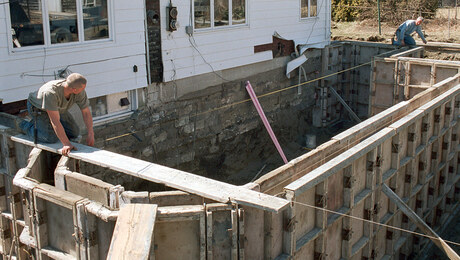Have a client who wants to have 2 dryers, because of the size of his family and their laundry requirements.
Current dryer is electric. Vented through the wall to the garage, then through probably 30 feet of 4″ PVC DWV pipe to the outside.
He would like to hook up a gas dryer next to the existing electric one. My proposed solution would be to replace the 4″ DWV with larger (6″ ?), and hook each dryer to this line.
Any problems with this? The 6″ gives over twice the cross-sectional area of the 4″ for exhaust. Any problems when only one dryer is running? What about the combustion exhaust from the gas dryer? Could it possibly re-enter the house through the other dryer?
Would the PVC have to be grounded, like in a dust collection system? I doubt the airflow would be great enough to build up enough of a charge to create a spark, but just want some confirmation either way.
Thanks in advance.
Pete Duffy, Handyman


















Replies
"Would the PVC have to be grounded, like in a dust collection system? I doubt the airflow would be great enough to build up enough of a charge to create a spark, but just want some confirmation either way."
3 things.
1. PVC is not suitable for clothes dryer. It should be metal.
2. PBC dust collectors don't need grounding to prevent sparks. Except in high volumne industrial applications with sanders (very fine dust) is there ever enough dust concentration that there is an explosion hazard. (note with any size and type of pipe there is still a fire hazard with sparks; such as grinding metal or metal embedded in wood being machines).
3. A clothes dryer exhaust is too moist to worry about static.
You basic question is interesing, however.
I wonder how they handle it in places like appartment buildings where they are several machines in one area.
I wonder if there are flappers that can be used on each dyer?
.
A-holes. Hey every group has to have one. And I have been elected to be the one. I should make that my tagline.
In my mind, the gas dryer is the problem. For example, if they run the kitchen exhaust hood at the same time they are running the gas dryer, the gas dryer exhaust is going to come back in the house through the other dryer.
The only way to make sure that you do not get the combustion exhaust back through the other dryer is to put in separate vents for each one. I do not think that any one way damper is going to seal well enough to solve the back draft issue, and it will inevitably collect lint and clog up as well.
With 30' of run, I would be very tempted to add a booster fan to each one as well.
The kitchen exhaust is on the other side of the house, so that's not a problem.
Think I'll go with separate metal ducts, just to be sure so I can sleep at night.
Thanks for the input.Pete Duffy, Handyman
Which side the kitchen exhaust is on isn't the issue. The problem is with the kitchen exhaust blowing air out, the house will be negatively pressurized.
Your right though, separate metal ducts is the only answer.
The dryer(s) will create a lot more negative pressure than the kitchen fan.
You still need to exhaust each dryer seperately.
In a new well sealed house, makeup air sounds good.SamT
Anyone who doesn't take truth seriously in small matters cannot be trusted in large ones either. [Einstein] Tks, BossHogg.
I agree that two separate vents solves any questions of one drier venting through the other. One thing to watch with metal vents, assuming the garage is unheated in the Chicago area is condensation. If they are not well sealed and properly sloped, they may leak. I run into this problem with drier vents run through attic areas in Toledo.
They should be vented separately all the way to the outside. Otherwise, a portion of the exhaust from either will come back in through the other appliance.
Here is a thought: Assuming 2 new metal ducts, maybe the existing 4" PVC could be used for makeup air. I think the newest mechanical code requires make-up air for dryers installed in closed areas - although it is not enforced in my state. Not that this is necessarily a code issue for you, but makeup air is a good thing since it keeps all the conditioned air from being sucked out of the house.
Our HVAC inspector would most likely require you to follow the venting directions in the installation manual of each drier for the least restrictive solution. Most likely you'd need two separate vents and booster fans with runs that long.
Beer was created so carpenters wouldn't rule the world.
should the vent become blocked the carbon monoxide will fillthe house from the gas dryer thru the electric.